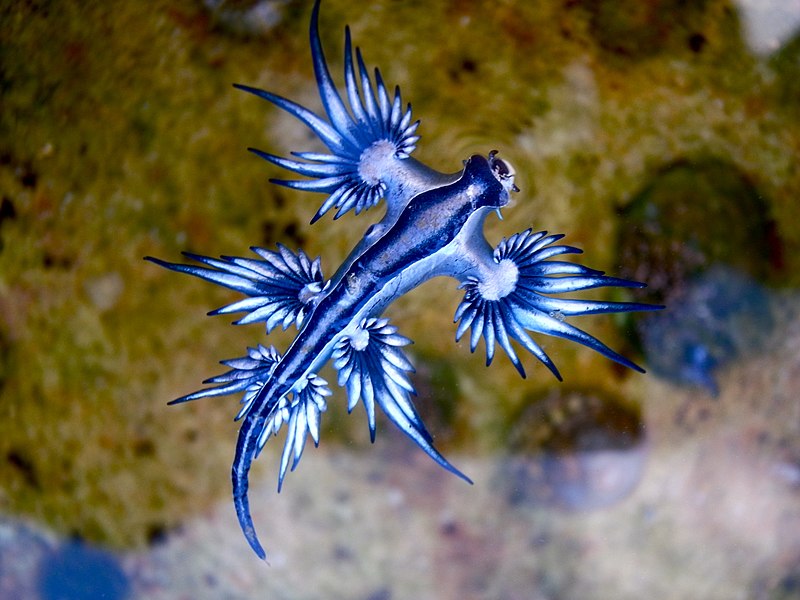By Kathryn Harris
If you know me, then it’s no secret that I LOVE molluscs, particularly marine molluscs. Ever since I was small I’ve been fascinated by these strange squishy looking creatures, often creating little homes for the snails in my garden and watching them slowly devour the plants in the border (much to my mother’s despair!). Now I am older and no longer keep snails as pets, but if you were to ask me what my favourite animal was, I would tell you that it was a sea bunny (Jorunna parva), a type of nudibranch. The most common reaction I’ve had to my answer is “what on earth is a nudibranch?” which is fair, I hadn’t heard of them either until a lecturer offhandedly mentioned them. To sum it up, nudibranch is a fancy word for sea slug, and although they look tropical, these colourful creatures are common around the UK.

The word nudibranch means naked gills, which refers to how their gills are on the outside of their body, rather than inside like with most fishes. On the top of their heads they also have two sensitive ‘tentacles’ called rhinophores, which they use as sensors to feel the world around them. This not only helps them to know where they’re going, but they also help the nudibranch to detect food. Nudibranchs can be carnivorous, eating other animals such as sponges, tunicates, barnacles and anemones. This isn’t surprising as nudibranchs aren’t great swimmers, so having a food source that can’t run away is a good strategy! When they find their prey, the nudibranch will use its radula (a tiny toothed ‘ribbon’ that cuts away at the prey), to get through any shells and devour the animal inside. Not all are carnivorous, some have a mutualistic relationship with algae that live in their outer tissues. In return for a safe place to live, the algae provides the nudibranch with sugars, which it produces via photosynthesis (hence why it lives in the outer tissues, so it still has access to sunlight!).

Nudibranchs are hermaphrodites, this means that they produce both male and female sex cells. In order to mate, two nudibranchs will come together side by side and trade sperm packets with each other- how romantic! The nudibranch will then keep the sperm given, and use it later to fertilise their eggs. Nudibranch eggs are laid in a spiral shape and look a bit like a ribbon or flower when attached to a rock.

Nudibranchs are found in such amazing colours and patterns, with tropical species being particularly bright. In fact, it’s likely they were the influence behind the design of the pokemon Gastrodon (its name even sounds a bit like Gastropoda which is the class that nudibranchs belong to). Since they have no hard outer shell, nudibranchs have had to find other ways to avoid predators, and the bright colours of the nudibranchs can be for camouflage or act as a warning signal to predators that they contain toxins. Nudibranchs that belong to the group Aeolida possess the amazing ability to steal the stinging defences of their prey and transfer them to their own body.

Cnidarians such as anemones and jellyfish have tiny stinging structures called nematocysts. When triggered by touch, these nematocysts act a lot like a harpoon gun, firing into an unsuspecting victim and injecting a paralyzing poison. Cnidarians are then able to eat their stunned prey without them getting away, however some nudibranchs are able to deflect the stings enabling them to munch on any cnidarian they like, although usually this is a sea anemone. When eating the cnidarian, the nudibranch recycles the nematocysts, turning them into cerata, which are long tentacle-like structure that comes off their backs. Now, any nudibranch predator that tries to take a bite will find themselves being stung!

There are around 3,000 known species of nudibranch in the world. These are most commonly found in shallow, tropical waters, but they are also present in the ocean and around every coast except for that of Antarctica and coast onto the Arctic Ocean, where it is too cold. Even though there are more tropical species of nudibranch, the temperate ones just as fascinating. Here are a couple of examples you might see in the waters around the UK:
- Archidoris pseudoargus, common name sea lemon, is the most common UK species and can grow up to 12cm in length!
- Polycera quadrilineata is much smaller and can grow up to 4cm in length, and is mostly translucent with bright orange spots over it’s body
- Flabellina pedata can grow up to 5cm long and is easily recognisable with its cerata which varies in colour from red to pink, to violet, and to orange
- Janolus cristatus is semi-transparent with iridescent blue cerata tips and can grow up to 7.5cm

So there you have it, not all slugs are bland and boring! The nudibranchs are a special and unique group of animals, with abilities that other animals could only dream of. So next time you’re by the rocky shore, or out snorkelling, remember to keep an eye out on the seabed for some of the local UK species. As this group can be very small and extremely well camouflaged, so it might be worth looking up some pictures of common species before you go searching so you know exactly what you’re looking out for.

